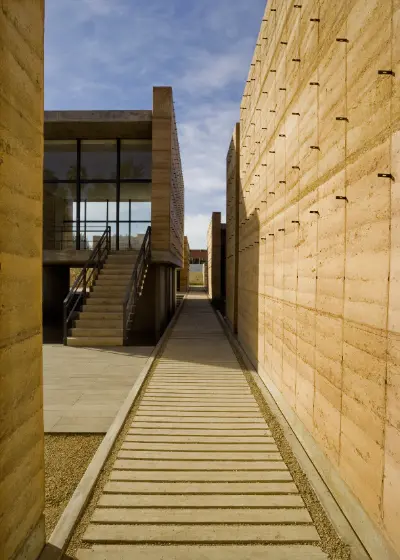造型艺术学院

下载所需积分: 5
这所艺术学校是为瓦哈卡本尼托·华雷斯自治大学而建。学校位于大学入口的一个显眼的拐角地块,设计旨在促进大学与城市之间的对话,同时保持低调,以培养艺术学校的创造性和内省特征。
项目的概念受到两个现有条件的影响:缺乏总体规划和校园内现有建筑之间统一的建筑语言,这些建筑将作为设计的背景,以及大学附近正在建设的项目产生的多余土壤。这促使人们将该综合体构思为一个广阔的花园,灵感来自于围绕和保护学校的土堤,类似于龟壳。从外部看,这个综合体呈现为一个花园,而从内部则足够隔离,以容纳艺术学校的设施。土堤高达3米,几乎完全掩盖了内部的学校,这是一组夯土和石材建筑,内有主大厅、画廊、媒体中心、行政办公室、教室和艺术工作室。石材建筑位于“火山口”的边缘,同时也用于支撑周围的土方工程。在综合体内部,主要朝北的夯土和混凝土建筑包含艺术工作室、画廊和主大厅,构成了学校的主体。与内部空间对话的是从每栋建筑延伸出的庭院,作为工作环境的延伸。庭院铺满了赭色的碎石,种植着一种春天开花、冬天光秃的墨西哥樱桃树,体现了综合体作为花园的理念。在体量上,建筑与庭院之间的实心与空洞的互动创造了不断变化的通道、视野和光线条件,随着人们在学校内的移动而变化。
在整个项目中,可持续性一直是一个核心关注点。主要的建筑材料夯土具有自然绝缘、防水、防火、抗白蚁、提供声学隔音,并利用当地可获得的土壤。此外,墙体是自支撑的。景观设计除了土堤的柔软表面外,还包括多孔的硬表面。雨水被储存于一个100,000升的水箱中,以备后用。内部空间没有机械供暖和制冷,而是依靠自然通风和厚重的墙体来保持空间在全年舒适。
这个花园被设想为整体不可或缺的一部分,建筑将有工作空间被植被环绕,创造一个舒适宜人的微气候,为瓦哈卡市提供另一个“肺”。
The art school was commissioned as a part of the Benito Juarez Autonomous University of Oaxaca. Located at the entrance to the university on a conspicuous corner site, the school was designed to both open a dialogue between university and city as well as remain discreet in order to foster the creative, introspective character of an art school.
The concept of the project was influenced by two existing conditions: the absence of a master plan and of a unified architectural language between existing buildings on campus that would serve as context for the design as well as the construction of nearby projects at the university that were generating excess earth. This led to the idea of the complex as an extensive garden, inspiring the talus that surrounds and protects the school akin to a tortoise shell. From the exterior the complex appears a garden and from the interior is sufficiently isolated to accommodate the facilities of an art school. Measuring 3-meters tall, the vegetal mound all but conceals the school inside, a complex of rammed earth and stone buildings that house a main hall, gallery, mediatheque, administration offices, classrooms and art studios. Stone buildings occupy the periphery of the “crater” and serve also to retain the surrounding earthwork. Inside the complex, the rammed earth and concrete edifices, principally North-oriented and containing the art studios, gallery, and main hall make up the body of the school. In dialogue with the interior volumes are the patios that project from each building as an extension of the work environment. Filled with ochre-colored gravel and planted with a Mexican cherry tree that flowers in spring and is bare in winter, the patios manifest the idea of the complex as garden. Volumetrically, the interplay of solid and void between building and patio creates ever changing pathways, vistas, and light conditions as one moves through the school.
Throughout the project sustainability has been a central concern. The principal construction material, rammed earth, is naturally insulating, water proof, fire resistant, termite-proof, provides acoustical insulation and makes use of locally- available earth. Also, walls are self-supporting. The landscaping, in addition to the soft surface of the talus, includes porous hard surfaces. Rain water is stored for later reuse in a 100,000-liter cistern. The interior spaces do not have a mechanical heating and cooling instead relying on natural ventilation and massive walls to keep the spaces comfortable year round.
The garden was envisioned as an indispensible part of the whole whereby the building will have work spaces surrounded by vegetation creating a comfortable and inviting microclimate and another lung for Oaxaca City.